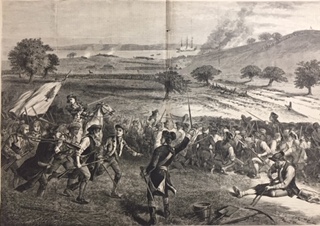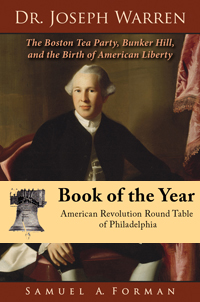Source: 19c engraving
Commentary: Among the handful of historical genre paintings most frequently appearing in history texts on the period, Trumbull’s Bunker Hill, as it is now most frequently known, is the oldest of them. The heroic battlefield death of Dr. Joseph Warren, an incident mourned nationally during the Revolutionary War and for several generations afterward, is the central vignette of Trumbull’s painting.
Additional artists during the 19th century focused on the Battle of Bunker Hill as a subject showcasing their historical genre artistry. Their works sometimes included Warren’s demise as a central subject; others included his demise, as if obligated to do so, but de-emphasize it in their composition; others delete it entirely.
I believe that today’s posted image has appeared only once and has been virtually lost thereafter. The image will be new to modern readers interested in Bunker Hill, Dr. Joseph Warren, and the Revolutionary War. Do return in future weeks for an additional image of this nature.
This engraving is notable in several respects. It provides a realistic perspective from the vantage point of the rail fence as American militiamen observe the British infantry gathering for an assault. Off to the right is Breed’s Hill, scene of the climax of the battle. In the further distance is Charlestown ablaze, and a British warship firing on the American positions. I speculate that the artist must have visited the battlefield, then only partly urbanized during the nineteenth century, when sketching geographic features of the battlefield as they may actually have appeared to participants during the battle on June 17, 1775. Col. Knowlton was one of the officers commanding troops at the rail fence. Inclusion of recognizably Afro-American militiamen reflects the reality of the battle, though participation of Black Americans in the conflict was often omitted in 19th century depictions. Less realistic elements include officers in uniform (there weren’t any formal uniforms at that juncture), flying of a Pine Tree flag at the rail fence (it remains unclear whether any flags were carried by Americans during the battle), and a mounted horseman (I don’t recall any accounts of mounted officers, or anyone else for that matter, on the battlefield).

 Follow
Follow